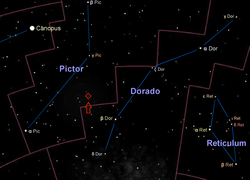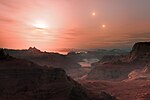 Location of HD 40307 in the night sky. The star is marked within the red diamond below the word "Pictor". | |
| Observation data Epoch J2000.0 Equinox J2000.0 (ICRS) | |
|---|---|
| Constellation | Pictor |
| Right ascension | 05 54 04.24050 |
| Declination | −60° 01′ 24.4930″ |
| Apparent magnitude (V) | 7.17 |
| Characteristics | |
| Spectral type | K2.5V |
| B−V color index | 0.93 |
| Astrometry | |
| Radial velocity (Rv) | 31.08±0.12 km/s |
| Proper motion (μ) | RA: −52.174±0.023 mas/yr Dec.: −60.059±0.025 mas/yr |
| Parallax (π) | 77.3261 ± 0.0170 mas |
| Distance | 42.179 ± 0.009 ly (12.932 ± 0.003 pc) |
| Absolute magnitude (MV) | 6.57±0.01 |
| Details | |
| Mass | 0.75 −0.04 M☉ |
| Radius | 0.716 ± 0.010 R☉ |
| Luminosity (bolometric) | 0.23 L☉ |
| Luminosity (visual, LV) | 0.20 L☉ |
| Surface gravity (log g) | 4.47 ± 0.16 cgs |
| Temperature | 4977 ± 59 K |
| Metallicity | −0.31 ± 0.03 dex |
| Rotation | 31.8±6.7 d |
| Rotational velocity (v sin i) | 3 km/s |
| Age | 1.2 (≥ 0.2) Gyr |
| Other designations | |
| CD−60 1303, CPD−60 508, GC 7474, GJ 2046, HIP 27887, PPM 355061, SAO 249388, 2MASS J05540421-6001245. | |
| Database references | |
| SIMBAD | data |
| Exoplanet Archive | data |
| ARICNS | data |
HD 40307 is an orange (K-type) main-sequence star located approximately 42 light-years away in the constellation of Pictor (the Easel), taking its primary name from its Henry Draper Catalogue designation. It is calculated to be slightly less massive than the Sun. The star has six known planets, three discovered in 2008 and three more in 2012. One of them, HD 40307 g, is a potential super-Earth in the habitable zone, with an orbital period of about 200 days. This object might be capable of supporting liquid water on its surface, although much more information must be acquired before its habitability can be assessed.
No stellar companions to HD 40307 were detected as of 2018.
History and nomenclature
HD 40307 was observed during or before 1900 as part of the Cape Photographic Durchmusterung. The designation HD 40307 is from the Henry Draper Catalogue, which is based on spectral classifications made between 1911 and 1915 by Annie Jump Cannon and her co-workers, and was published between 1918 and 1924.
Characteristics
As a K-type star, HD 40307 emits orange-tinted light. It has only about three-quarters of the Sun's radius and mass. Its temperature is measured at slightly under 5,000 K.
The astronomers who discovered the planets orbiting HD 40307 suggested that the metallicities of stars determine whether or not the planetary bodies that orbit them will be terrestrial, like Earth, or gaseous, like Jupiter and Saturn.
Distance and visibility
Despite its relative proximity to the Sun at 42 light-years, HD 40307 is not visible to the naked eye, given its apparent magnitude of 7.17. It came within 6.4 light-years of the Sun about 413,000 years ago.
Planetary system
A planetary system around HD 40307 contains four confirmed planets and two other possible planets, all within 0.6 AU of the star.
| Companion (in order from star) |
Mass | Semimajor axis (AU) |
Orbital period (days) |
Eccentricity | Inclination | Radius |
|---|---|---|---|---|---|---|
| b | ≥ 4.0 −0.7 M🜨 |
0.0468 −0.0024 |
4.3123 −0.0012 |
0.20 −0.14 |
>0.2022° | — |
| c | ≥ 6.6 −1.0 M🜨 |
0.0799 ± 0.0040 | 9.6184 −0.0049 |
0.06 −0.11 |
>0.2109° | — |
| d | ≥ 9.5 −1.5 M🜨 |
0.1321 −0.0064 |
20.432 −0.024 |
0.07 −0.07 |
>0.2855° | — |
| e (disputed) | ≥ 3.5 ± 1.4 M🜨 | 0.1886 −0.0104 |
34.62 −0.20 |
0.15 −0.15 |
— | — |
| f | ≥ 5.2 −1.6 M🜨 |
0.247 −0.014 |
51.76 −0.46 |
0.02 −0.02 |
— | — |
| g (disputed) | ≥ 7.1 ± 2.6 M🜨 | 0.600 −0.033 |
197.8 −5.7 |
0.29 −0.29 |
— | — |

After spending five years observing the star, the European Organisation for Astronomical Research in the Southern Hemisphere (ESO) announced that they had discovered three super-Earths in orbit around HD 40307 in June 2008. All three planets were detected by the radial velocity method, using the HARPS spectrograph system.
In 2012, an independent analysis carried out by a team of astronomers led by Mikko Tuomi of the University of Hertfordshire confirmed the existence of these planets and found an additional three planets in the systems. The planet HD 40307 f on 51.6-day orbit was confirmed in 2015, with inconclusive evidence for the planets HD 40307 e and HD 40307 g.
Five of the planets orbit very close to the star, with the farthest of them located twice as close to HD 40307 than is the planet Mercury is to the Sun. The outermost planet orbits at a distance similar to the distance of Venus to the Sun and is situated well in the system's liquid water habitable zone.
The minimum masses of the planets in the system ranges from three to ten times the mass of the Earth, placing them somewhere between Earth and gas giants like Uranus and Neptune. Dynamical analysis of the innermost planets suggests that planet b is unstable at its age unless it is an ice giant, having migrated from further away. That implies similar for the other planets, even further out. The most recent discovery also indicates via dynamical analysis that the true planetary masses can not be much higher than their minimum masses.
See also
- List of multiplanetary systems
- List of extrasolar planets
- Other stars with planets discovered in June 2008:
Notes
- Using the absolute visual magnitude of HD 40307 and the absolute visual magnitude of the Sun , the visual luminosity can be calculated by
- Mercury orbits at approx. 0.39 AU
References
- ^ Vallenari, A.; et al. (Gaia collaboration) (2023). "Gaia Data Release 3. Summary of the content and survey properties". Astronomy and Astrophysics. 674: A1. arXiv:2208.00211. Bibcode:2023A&A...674A...1G. doi:10.1051/0004-6361/202243940. S2CID 244398875. Gaia DR3 record for this source at VizieR.
- ^ HD 40307, entry, SIMBAD. Accessed online June 18, 2008.
- Holmberg, J.; et al. (July 2009). "The Geneva-Copenhagen survey of the solar neighbourhood. III. Improved distances, ages, and kinematics". Astronomy and Astrophysics. 501 (3): 941–947. arXiv:0811.3982. Bibcode:2009A&A...501..941H. doi:10.1051/0004-6361/200811191. S2CID 118577511.VizieR
- ^ HD 40307, database entry, Geneva-Copenhagen Survey of Solar neighbourhood, J. Holmberg et al., 2007, CDS database V/117A, accessed November 19, 2008; described in The Geneva-Copenhagen survey of the Solar neighbourhood. Ages, metallicities, and kinematic properties of ~14 000 F and G dwarfs, B. Nordström, M. Mayor, J. Andersen, J. Holmberg, F. Pont, B. R. Jørgensen, E. H. Olsen, S. Udry, and N. Mowlavi, Astronomy and Astrophysics 418 (May 2004), pp. 989–1019, Bibcode:2004A&A...418..989N, doi:10.1051/0004-6361:20035959.
- HD 40307, entry, CDS database J/A+A/450/735; described in Effective temperature scale and bolometric corrections from 2MASS photometry, E. Masana, C. Jordi, and I. Ribas, Astronomy and Astrophysics 450, #2 (May 2006), pp. 735–746. Bibcode:2006A&A...450..735M. doi:10.1051/0004-6361:20054021.
- ^ M. Mayor; S. Udry; C. Lovis; F. Pepe; D. Queloz; W. Benz; J.-L. Bertaux; et al. (2009). "The HARPS search for southern extra-solar planets. XIII. A planetary system with 3 Super-Earths (4.2, 6.9, & 9.2 Earth masses)". Astronomy and Astrophysics. 493 (2): 639–644. arXiv:0806.4587. Bibcode:2009A&A...493..639M. doi:10.1051/0004-6361:200810451. S2CID 116365802.
- Suárez Mascareño, A.; et al. (September 2015). "Rotation periods of late-type dwarf stars from time series high-resolution spectroscopy of chromospheric indicators". Monthly Notices of the Royal Astronomical Society. 452 (3): 2745–2756. arXiv:1506.08039. Bibcode:2015MNRAS.452.2745S. doi:10.1093/mnras/stv1441.
- Jeanna Bryner (June 16, 2008). "Three super-Earths found around one star". NBC News. Archived from the original on December 13, 2013. Retrieved June 18, 2008.
- ^ Amina Khan (November 7, 2012). "Possible Earth-like planet could hold water; scientists cautious". Los Angeles Times. Retrieved November 8, 2012.
- ^ Tuomi, Mikko; Anglada-Escudé, Guillem; Gerlach, Enrico; Jones, Hugh R. A.; Reiners, Ansgar; Rivera, Eugenio J.; Vogt, Steven S.; Butler, R. Paul (17 December 2012). "Habitable-zone super-Earth candidate in a six-planet system around the K2.5V star HD 40307". Astronomy & Astrophysics. 549: A48. arXiv:1211.1617. Bibcode:2013A&A...549A..48T. doi:10.1051/0004-6361/201220268. S2CID 7424216.
- Wall, Mike (November 7, 2012). "'Super-Earth' Alien Planet May Be Habitable for Life". Space.com. Retrieved November 8, 2012.
- Tate, Karl (November 7, 2012). "Super-Earth Planet: Potentially Habitable Alien World Explained (Infographic)". Space.com. Retrieved November 8, 2012.
- Dietrich, J.; Ginski, C. (2018). "Archival VLT/Na Co multiplicity investigation of exoplanet host stars". Astronomy & Astrophysics. 620: A102. arXiv:1811.09666. Bibcode:2018A&A...620A.102D. doi:10.1051/0004-6361/201731341. S2CID 119294338.
- CPD−60 508, database entry, Cape Photographic Durchmusterung (CPD), D. Gill and J. C. Kapetyn, 1895–1900, CDS ID I/108.
- pp. 214–215 in The Henry Draper Memorial, Annie J. Cannon, Journal of the Royal Astronomical Society of Canada 9, #5 (May–June 1915), pp. 203–215, Bibcode:1915JRASC...9..203C.
- The Henry Draper Catalogue, Annie J. Cannon and Edward C. Pickering, Annals of Harvard College Observatory;
hours 0 to 3, 91 (1918), Bibcode:1918AnHar..91....1C;
hours 4 to 6, 92 (1918), Bibcode:1918AnHar..92....1C;
hours 7 to 8, 93 (1919), Bibcode:1919AnHar..93....1C;
hours 9 to 11, 94 (1919), Bibcode:1919AnHar..94....1C;
hours 12 to 14, 95 (1920), Bibcode:1920AnHar..95....1C;
hours 15 to 16, 96 (1921), Bibcode:1921AnHar..96....1C;
hours 17 to 18, 97 (1922), Bibcode:1922AnHar..97....1C;
hours 19 to 20, 98 (1923), Bibcode:1923AnHar..98....1C;
hours 21 to 23, 99 (1924), Bibcode:1924AnHar..99....1C. - "Stellar Magnitudes". Astrophysics 162 Unit. University of Tennessee. 2008. Retrieved 20 November 2008.
- Bobylev, Vadim V. (March 2010). "Searching for Stars Closely Encountering with the Solar System". Astronomy Letters. 36 (3): 220–226. arXiv:1003.2160. Bibcode:2010AstL...36..220B. doi:10.1134/S1063773710030060. S2CID 118374161.
- ^ Díaz, R. F.; et al. (2016). "The HARPS search for southern extra-solar planets. XXXVIII. Bayesian re-analysis of three systems. New super-Earths, unconfirmed signals, and magnetic cycles". Astronomy and Astrophysics. 585. A134. arXiv:1510.06446. Bibcode:2016A&A...585A.134D. doi:10.1051/0004-6361/201526729. S2CID 118531921.
- Kiefer, F.; Hébrard, G.; Lecavelier Des Etangs, A.; Martioli, E.; Dalal, S.; Vidal-Madjar, A. (2021). "Determining the true mass of radial-velocity exoplanets with Gaia". Astronomy & Astrophysics. 645: A7. arXiv:2009.14164. Bibcode:2021A&A...645A...7K. doi:10.1051/0004-6361/202039168. S2CID 221995447.
- "HD 40307 / CD-60 1303". SolStation. Sol Company. 2008. Retrieved 27 November 2008.
- Mayor; et al. (2008-06-16). "Trio of 'super-Earths' discovered". BBC News. Retrieved 2008-06-16.
- "Mercury Fact Sheet". NASA Goddard Space Flight Center. November 30, 2007. Retrieved 2008-11-12.
- Barnes, Rory; Jackson, Brian; Raymond, Sean N.; West, Andrew A.; Greenberg, Richard (January 13, 2009). "The HD 40307 Planetary System: Super-Earths or Mini-Neptunes?". The Astrophysical Journal. 695 (2): 1006–1011. arXiv:0901.1698. Bibcode:2009ApJ...695.1006B. doi:10.1088/0004-637X/695/2/1006. S2CID 18849636.
External links
- A Trio of Super-Earths: A harvest of low-mass exoplanets discovered with HARPS, press release, European Southern Observatory, ESO 19/08, June 16, 2008.
| HD 40307 system | |
|---|---|
| Stars | |
| Planets | |
| Constellation of Pictor | |||||||||||
|---|---|---|---|---|---|---|---|---|---|---|---|
| Stars |
| ||||||||||
| |||||||||||
| Galaxies |
| ||||||||||
| 2012 in space | ||
|---|---|---|
| Space probe launches |
|    |
| Impact events | ||
| Selected NEOs | ||
| Exoplanets |
| |
| Discoveries | ||
| Comets | ||
| Space exploration | ||
 and the absolute visual magnitude of the Sun
and the absolute visual magnitude of the Sun  , the visual luminosity can be calculated by
, the visual luminosity can be calculated by 